Director Colin Trevorrow wrapped up the modern Jurassic World trilogy in dramatic (and familiar) fashion with Jurassic World Dominion, which brought back many of the original characters and dinosaurs from the original Jurassic Park films.
The Dominion team did so with a mix of practical and visual effects, in keeping with the franchise’s storied tradition of mixing in-camera movie magic with groundbreaking digital animation techniques. In addition to a visual effects team led by ILM’s David Vickery, Dominion relied on John Nolan Studio to create practical, animatronic creatures that added a physical component to the film’s menagerie.
Digital Trends spoke to John Nolan, who served as the live-action dinosaur supervisor on Jurassic World Dominion, about the work he and his team did on the film.
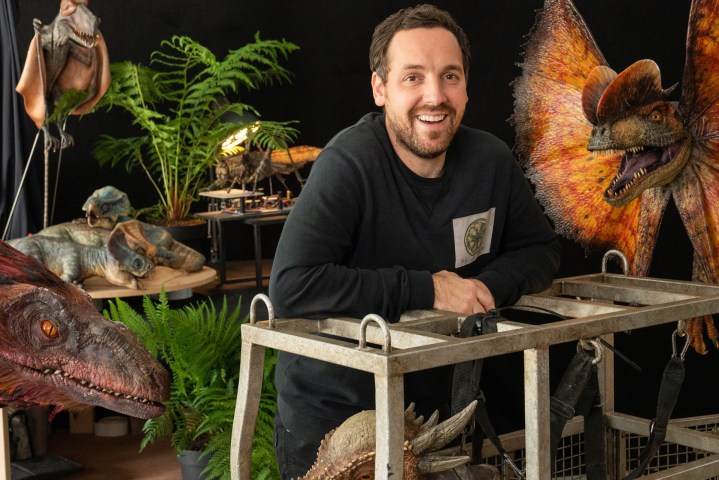
Digital Trends: It’s so difficult to see the division between animatronics and CG in a film like this, so what was the scope of your team’s work on the film? How many dinosaurs did you end up creating?
John Nolan: Well, it was the most in any of the Jurassic [films] so far. We created 14 different species and 48 dinosaurs in total. The Giganotosaurus, that was the biggest. That one was crazy.
What goes into building the dinosaurs and getting their look and movements just right?
All the dinosaurs are actually designed, the size of it and everything else, by Kevin Jenkins, the production designer, and his team. And then, of course, there’s Steven Spielberg, Steve Brusatte, the paleontologist, and everyone else, too. So that job is made easy for us.
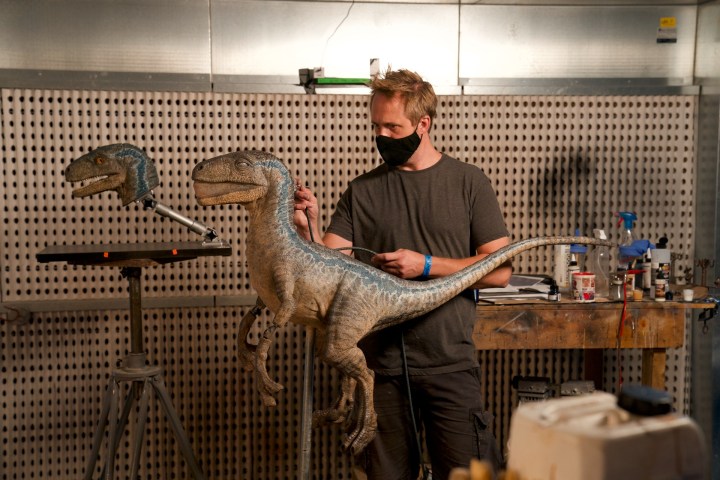
For the movement, we could look at previous films for dinosaurs’ walking animation and such, but there’s always some artistic license in our work. For example, if a dinosaur needs to walk around, we can look at walking cycles from ILM and then have our puppeteers perform those walking cycles. With regards to eye movements and mouths and tongues and stuff, we can have a bit of artistic license there, too, and try some stuff out. As long as the dinosaur is the right size, with the right amount of scaling, and it moves in the right way, all of those smaller features we can actually have a bit of fun with and try to make it as organic as possible.
How do you approach making the dinosaurs expressive in their facial movements and such?
Puppeteering is tricky, but if you’ve got a puppet and you’ve got up to 12 puppeteers, it’s almost like an orchestra performing. The second you get ahold of that puppet, there are so many different looks you can get from it and so many different expressions. You give a sock to a good puppeteer and they can turn it into a character, you know? We worked with amazing puppeteers. Derek Arnold, our puppeteer captain, is incredible. It’s a challenge, but that’s the exciting stuff for us.

You mentioned this one earlier, but tell me about your work on the Giganotosaurus. It was one of the stars of the film, after all.
Well, we initially had a list of dinosaurs and the Giga wasn’t on it. A year into the job, we heard that Colin might want this dinosaur for some in-camera scenes. So we had about six months to build it, but because of COVID and scheduling and stuff, we started to lose time. The producers said, “We’ve got three months to do this. Do you think you can still put it off?” What was good about Giga was that it ended up being the work of three departments working together. We had visual effects, special effects, and creature effects all working as one department to build this character.
When we were trying to find stuff that existed back in ’93, there was not that much material. We basically started off with a model from ILM — a sort of 3D model in a Z-Brush sculpting program — and we spoke to Colin and worked out exactly how much he wanted to achieve in-camera. He wanted it to be just in front of Giga’s shoulders, running down the back of the neck.

So what went into building the practical version of the dinosaur?
We used a robotic arm to cut a 1:1 scale version of Giganotosaurus out of polystyrene, which became the basis for our sculpture. We then skimmed the polystyrene — almost like icing a cake — with oil-based clay, and had 20 sculptors replicating all the details that exist on the CG model. Then we molded it, made the skin, built the robot, and then on set, we actually had the visual effects animation team control the puppet along with our live control. This made it so Colin could shoot as much in-camera as possible and then just extend the back of the dinosaur that isn’t there in post-production. It was a really lovely way of working because it pulled all three disciplines together.
What about Therizinosaurus?
I love that one, but you know what? All we did was the head on a stick.
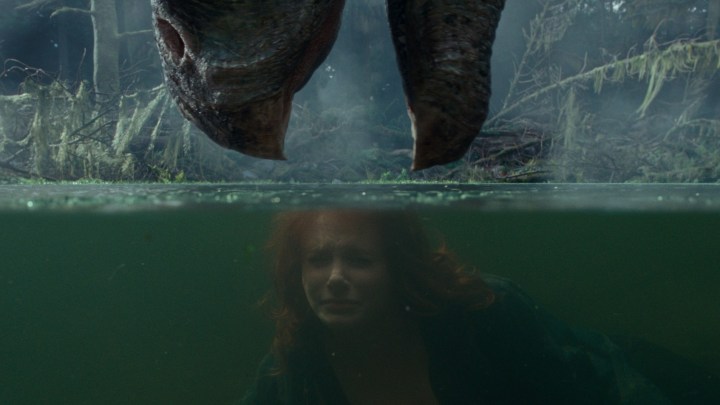
Really?
Yeah. That’s what was so good about the level of quality of ILM and David Vickery and his team. We had a huge creature shop and were building so many practical puppets, and their team would often look at what we were doing for reference. They’d film our practical puppets and apply that live, puppeteered performance to their animated characters. So even though we didn’t build anything for that character, there was such a wonderful overlap and appreciation between departments. We were influenced by them, and they were influenced by us. And I hope that shows in all characters.
What about the Pyroraptor?
We were asked to build an animatronic head for that one, but not to be used in-camera at all. The reason they wanted to build an actual working puppet, though, was so the visual effects team could see the feathers and how they move across the neck. Finola McLennan, our head of feathering and fur, had her team dye each individual feather to match the artwork from Kevin Jenkins. Each individual feather was woven into a net that went onto the animatronic head. Although it didn’t make it into the film, it was such an amazing tool for ILM to have on set.

Moving from dinosaurs to the other creatures built for the film, the giant locusts, what went into their creation?
Yeah, they were disgusting. Just horrible. But seriously, it was lovely, because we were able to take a 3D model and then 3D-print all the parts out for the locusts. We had around 120 small, tiny little parts. There were eight mandibles that could eat food. We had to keep all the animatronics away from the head, though, because Colin wanted loads of wet slime inside the mouth. The head could move in every direction, the body could lift up and down and spin around, and the four wings could lift and flutter.
In the film, when they go berserk, we knew there would be a takeover of them with visual effects, so they could enhance our animatronic and embellish it with even more movement. So when you see the locust puppet in the film, it’s enhanced with CG and it looks so good. We were really pleased with that, because it’s great for Colin and John Schwartzman [the director of photography] to have something they can actually shoot and light, and for the cast to interact with. It’s another great crossover between the departments.
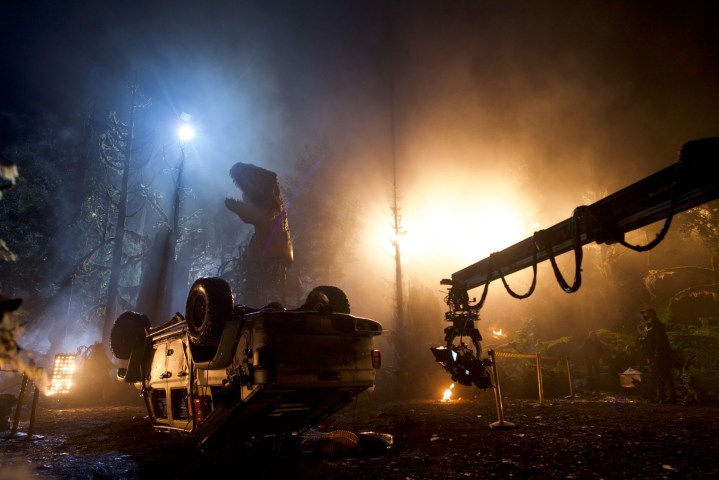
What was the most challenging scene for your team? Was there a scene that had more animatronic characters than the rest?
There were eight practical dinosaurs in the Malta scene. What a crazy scene that was. For the Lystrosaurus, it was five puppeteers in a box underneath the floor. There were three people painted out with visual effects around the Dimorphodon. We had someone with their hand up the back of the Stygimoloch, which looked like someone was trying to birth a cow. You can see it on the DVD’s “Making Of” feature.
But really, I would love to know whether people think certain characters are CG or in-camera, because that’s part of our job: All we care about is that they believe in the character and believe it’s real.
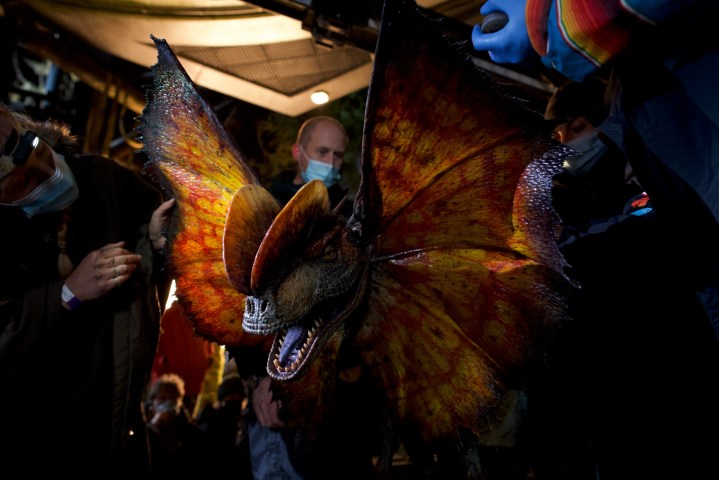
A lot of elements were brought back from the original Jurassic Park for this film. What was that experience like for you and your team?
Being handed the baton for the dinosaurs in a Jurassic film is just an incredible honor. You look at the artists and studios that came before, and it’s just amazing. Having Jeff Goldblum and Laura Dern come into the creature shop and touch these puppets, and tell us their anecdotes of filming in ’93 — it was an amazing honor to be given the opportunity to do this. This is what made so many of us get into this business to begin with.
Directed by Colin Trevorrow, Jurassic World Dominion is available now on 4K, Blu-ray, and Digital On-Demand in a special extended edition.



